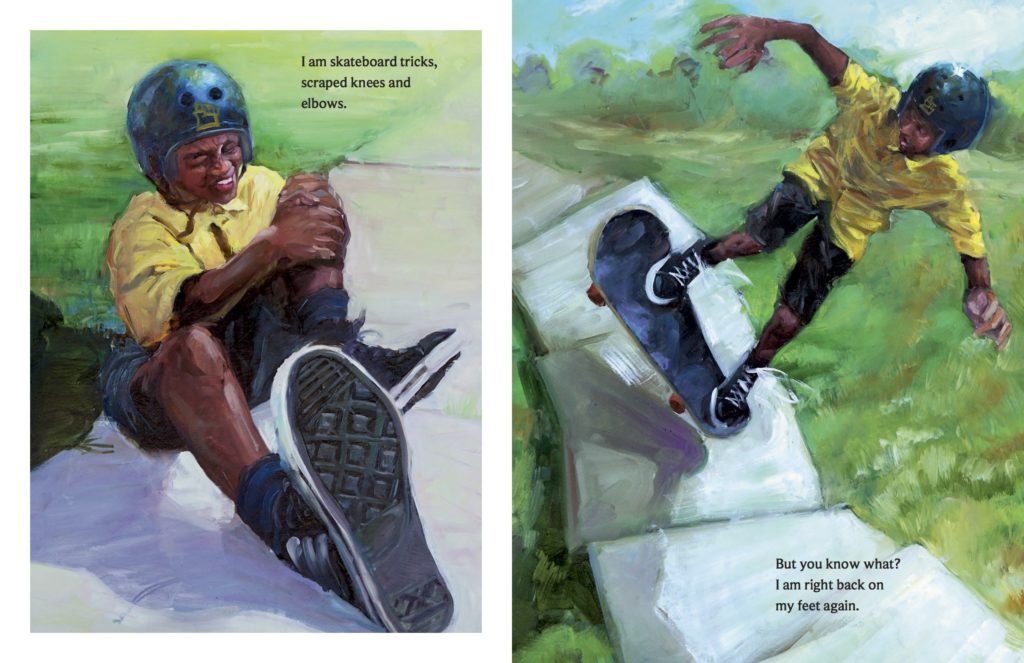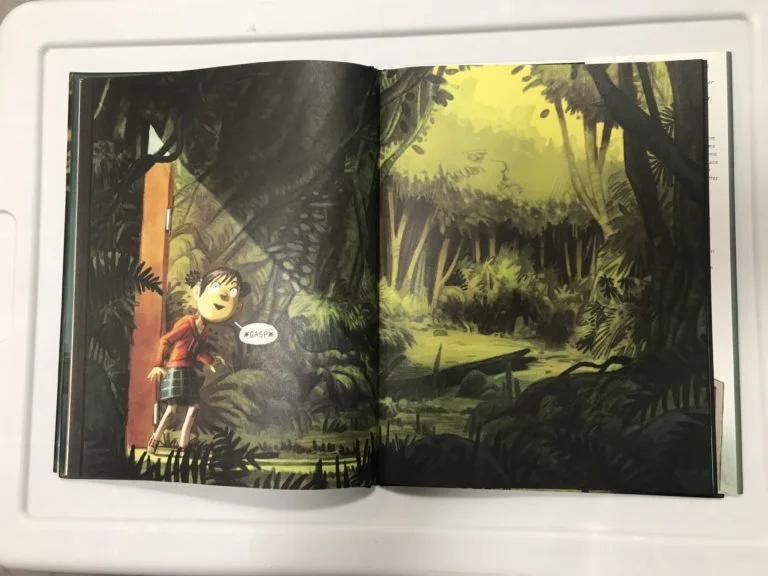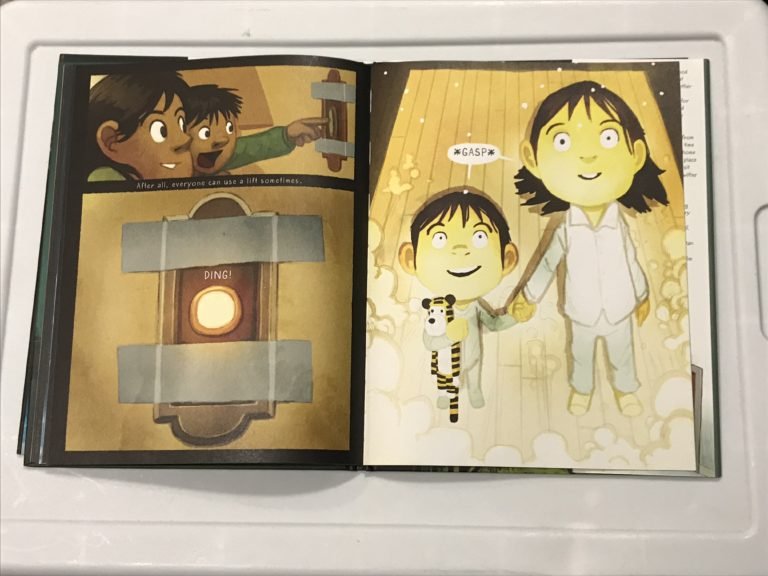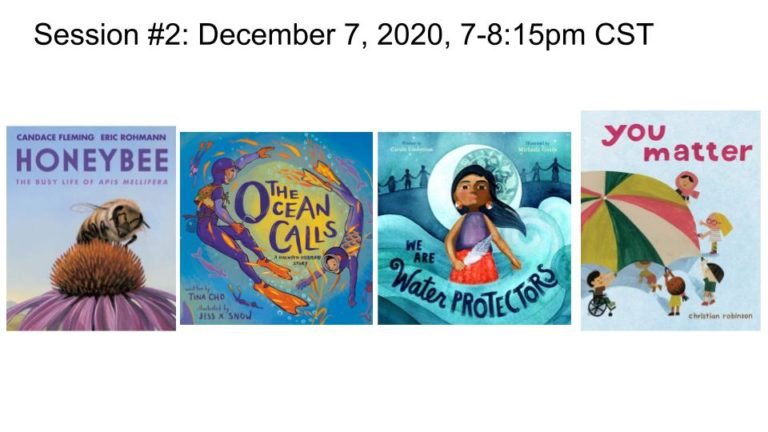Caldecott Club 2020: Session 1
First posted November 14th, 2020
We have come full circle during this, our 4th Caldecott Club, inspired by the fantastic program that Brian Wilson created at Evanston Public Library in 2016. This year we are hosting a collaborative virtual Caldecott Club WITH Mr. Brian and Evanston Public Library. Things will be a bit different in our virtual program, but the joyful fun of exploring awesome books together will be the same. And now we have the opportunity to welcome people from across our community – and beyond – to celebrate beautiful picture books together!
We met together on Zoom on November 9 with a group of wonderful readers, their families, and friends to talk about all things picture books. We were even joined by friends in other states, including teachers and a library school student! We were joined by our program buddy, Ms. Ann, and our Evanston Library buddies, Laura and Louise.
We designed this program to be open to kids from around 1st grade through 8th grade because picture books are for everybody and everyone can learn from each other. I’ve tried to recap their brilliance in this post.
We began our program by reviewing what the Caldecott Award is. Mr. Brian shared how it is the award for the most distinguished American picture book for children, given out each year by the Association for Library Service to Children. He pointed out last year’s Caldecott medal winner, The Undefeated, illustrated by Kadir Nelson, written by Kwame Alexander, as well as the Honor books, Bear Came Along, illustrated by LeUyen Pham, written by Richard T. Morris, Double Bass Blues, illustrated by Rudy Gutierrez, written by Andrea J. Loney, & Going Down Home With Daddy, illustrated by Daniel Minter, written by Kelly Starling Lyon. Thank you to Curt Leppert at Baker & Taylor who has shared print posters with us in years past – and provided this graphic for us to use this year. You can find it in our resources.
Mr. Brian then talked about the criteria for evaluating picture books. Shoutout to Holly Jin at Skokie Public Library for sharing this resource with me in past years to make the evaluation language more accessible. Brian and I emailed the criteria handout to those who registered to print out or view during the program if they wanted to use it.
Once we established our criteria, we were ready to explore the books. Mr. Brian put the books in a cardboard box, so he could dramatically open it just like the grown-up committee does when books arrive in the mail.
The books we discussed in session 1 were:
A Girl like Me by Angela Johnson, illustrated by Nina Crews
I Am Every Good Thing by Derrick Barnes, illustrated by Gordon C. James
Lift by Minh Lê, illustrated by Dan Santat
The Old Truck by Jerome Pumphrey & Jarrett Pumphrey
I guess this is the place I should put a spoiler alert for all the books we’re discussing…
Picture Walk
Rather than doing a formal read aloud of each book, we did picture walks. For the picture walk, we discussed each book’s visual features to examine the techniques the artists used and how they worked. Often we would prompt the group by asking them: How well does this book do what it’s trying to do? What did you notice? What does it make you wonder? How does this page make you feel? What makes this art distinguished? (Shout out to Megan Dowd Lambert’s Whole Book Approach. I highly recommend her book, Reading Picture Books with Children: How to Shake Up Storytime and Get Kids Talking about What They See.)
We used a strategy that ended up working well last year in person: scanning in the books so everyone could see them. While we had our copies of the physical books (insert my soapbox about books as objects, case cover secrets, and the texture and smell of picture books), it was very helpful to have digital versions to share with the group. We also added to our usual picture walk toolbox by encouraging participants to share and listen in lots of ways. People could unmute themselves and talk, raise their hands, use the chat, and use the reactions – and people did all of these things throughout the program, so ended up having a rich discussion in many places at the same time.
A Girl like Me by Angela Johnson, illustrated by Nina Crews
I (Eti) began our discussion by sharing some of the behind-the-scenes details about Nina Crews’ process to make A Girl Like Me. According to Nina, she made “patterns, scanned hand-made textures and used vector shapes created in Photoshop and collaged these with my photographs.” I was able to share some process pictures including thumbnails, sketches, and photoshoots she did with real girls – and emphasize how these real kids are the stars of this book, with their names on the copyright page and facts about them at the end. It was also able to share it as an ebook directly from Hoopla, which you can borrow and read without any waiting.
We began our discussion about A Girl Like Me by talking about the crowds of people who tell the girl who is flying that she shouldn’t be. L & S said, “they look mad.” We talked about Nina Crews used silhouettes to personify the crowds of naysayers – and how the girls have the color and focus on the page. When we explored the spread about the girl in the flowing scarves and a cowgirl hat, another participant pointed out, “she looks confident and brave.” Another participant noticed how “the building is slanted away from us and she’s standing upright, so she’s almost popping out of the building.” Another reader pointed out, “isn’t there a saying, on top of the world?” which is really the perfect way to express the emotions you feel looking at this spread. When we explored the spread with the girl swimming, someone pointed out that “her face makes it look like she’s trying to be a fish.” Ms. Ann commented, “This one is my favorite — she looks like a beautiful mermaid!!” Someone else added, “she looks like a dolphin too, when you see pictures of dolphins jumping out of the water.”
When the girls find community in the real world, people pointed out how much fun they are having with the capes and hats – and there are no grown-ups. We talked about how when the girls come together in the real world, walking past tall buildings, Nina Crews composed the real world elements to still feel fantastical. When we talked about the spread of the girls looking up at the butterflies on the way to the ocean, people pointed out how butterflies symbolize freedom and “they can do what they want.” Y & Z shared, “They chose butterflies because Monarchs migrate which means they are free.” We talked about the finale at the beach where they are all exploring their own interests. Another reader pointed out the buildings in the background, where they have journeyed from, perhaps swimming or boating to the beach. We talked about Nina Crews’ use of different geometric shapes throughout the book and what they symbolize. L. shared that “I think she used the stars because they are having fun.”
I Am Every Good Thing by Derrick Barnes, illustrated by Gordon C. James
Mr. Brian began his picture walk of I Am Every Good Thing by sharing that the boy on the cover is the illustrator, Gordon C. James’s, son, Gabriel. Gordon C. James shared in an NPR interview, “My son is autistic, and so he doesn’t often get asked to do things or asked to be the center of things…It was powerful to illustrate his child “looking like how I feel he sees himself and how we see him as his family.” Mr. Brian shared how it is a celebration of joyful Black boyhood. He shared how the boys are doing different things throughout the book with the oil painting art sometimes being realistic and sometimes being expressionistic to show the feelings and moods the boys are feeling. We talked about how much we love the cover and how it makes you feel – and the sensory experience of the textured gold lettering.
We talked about how Derrick Barnes dedicated the book to Tamir Rice, Trayvon Martin, EJ Bradford, Jordan Edwards, Michael Brown, Jordan Davis, and Julian Mallory, who were Black young people who were killed, who come from families who love them and are unconditionally deserving of love and a future. Gordon dedicated the book “to my son, Gabriel, and all little brothers like him.”
Our journey began with the flying boy. A reader shared, “I really like this picture because he looks like flying – but it really looks realistic like a regular kid who happens to have wings on him.” D. pointed out that the “cape looks like feathers of a bird.” Y & Z shared, “he’s going fast.”
Mr. Brian then pointed out how the next spread of the boys playing in the snow is more realistic. Ms. Ann pointed out the shadows on the spread make it look like “like during real winter.” We then talked about the skateboarding boy and how he felt after falling down. L. shared, “You can’t give up right away because you’d never do it again and then you would think about it and maybe want to try again.” Another reader shared how they did that with their bike. Our group noticed how determined he looks. L. shared that “I like the sole of his shoe.” (I literally never noticed it until this kid pointed it out, which is amazing!) Mr. Brian pointed out how Gordon C. James’ art draws your eye to the shoe and makes it look real.
Mr. Brian then showed how the next spread is more fantastical with the boy looking into the microscope and the other exploring space. He drew our attention to how the art in the background reveals what the boys are looking at, mixing molecules and the cosmos. L & S shared that “it seems like the book is showing different jobs.”
We talked about how Gordon C. James hired models to inspire the kids throughout the book, which helps make it all feel real. The next spread returns to realism with the boy standing with his grandmother “looking at something intently,” according to Y & Z.
Mr. Brian asked about the emotions on the “coooooooool breeze” spread with people pointing out how happy and silly the boys look. They personify that perfect paper airplane metaphor with the joyful fun they are having. On the next spread, L & S pointed out that “he seems like a star himself.”Mr. Brian asked if we’d want to join the boys having fun in the pool, which we wholeheartedly agreed we’d love to do. He talked about how the colorful art expresses this joy. Mr. Brian talked about how the art expresses movement on the page where he’s playing basketball and baseball.
On the next spread, the kids shared how he looks “serious and calm” when “people are saying bad things to him.” Ms. Ann pointed out he looks “strong with the halo behind him.” Mr. Brian shared how the words hurt but he doesn’t let them defeat him.
Mr. Brain shared how amazed he is by the versatility in the art in showing so many different experiences and settings to convey the themes of the book. As Gordon C. James shared, “I wanted through the illustrations for these kids to feel empowered …I want them all to feel like they belong everywhere, like there are no limits to the places they should be, or the things that they can be. No part of this life — this full, amazing life — should be off limits to you just because of who you are.”
Mr. Brian talked about the double-page spread showing their ancestors and successful Black men who have come before them – with the confident boys at the front of the spread, looking directly at the reader, happy and proud. We admired the final spread of the boy who is very expressive, declaring, “I am worthy to be loved.”
Good news! You can participate in the Penguin Kids #IAmEveryGoodThingContest. Here are the details: “Do your kids have their own affirmations like the ones in the uplifting picture book? We want to see them! Submit a photo of your kid holding a sign that says “I Am…” followed by a positive adjective for a chance to win a custom portrait from Gordon C. James! There are two ways to enter: 1) Share your photos on Instagram using the hashtag #IAmEveryGoodThingContest 2) Submit using this link. The contest ends November 30 – but sharing affirmations is forever.
We then took a quick movement break to get our wiggles out. People could participate by doing jumping jacks or whatever they preferred to move a bit after sitting through two picture walks.
Lift by Minh Lê, illustrated by Dan Santat
Mr. Brian began the picture walk by asking us who likes graphic novels. Everyone’s hands went up. He shared how Minh Lê also loves graphic novels and wrote the amazing Green Lantern: Legacy graphic novel, which is illustrated by Andie Tong. (We’ll actually be discussing it at Books & Bites in the winter!) He shared that Dan Santat also loves graphic novels – and created Lift basically like a comic book brought to life. This is also a funny book, so he encouraged us to look for the comical expressions, body language, perspective, and camera angles!
Mr. Brian pointed out how Dan Santat shows motivation on the characters’ expressions and body language. We noticed how Iris is surprised by the baby pressing the button, then mad, and then green with envy. Then betrayal again! Mr. Brian shared how miserable everyone is after Iris presses all the buttons. He then pointed out how we’re looking up at Iris from the garbage can when she looking at the broken elevator button and what an innovative way it is to show perspective. (Is it just me or is the elevator repair man a Stan Lee cameo? Can we just make this canon?)
Mr. Brian showed the power of the dramatic page turn going from the button dinging and Iris traveling through the door. As A. pointed out, “welcome to Narnia.” Mr. Brian pointed out the realistic tiger in the jungle, connecting to the stuffed tiger in the real world. Ms. Ann pointed out, “The tiger has Iris’s name on its belly!! It must have been hers!” D. pointed out, “I think she wants to go back because she realizes the tiger is “her” tiger.” Mr. Brian showed how the art reveals how unhappy Iris is compared to how fun her sibling and babysitter are having – making it a hilarious sequence.
We had a great prediction suggesting that Iris would go to outer space. As Iris lifts off the floor, a reader pointed out that it looks like no gravity. After the dramatic page turn, Y & Z pointed out that “it looks like the International Space Station.” Ms. Laura pointed out, “that’s a magic button!”
Mr. Brian pointed out how Iris finally smiles after she has the lovely moment with her sibling reading Summit – and decides to bring them with her to the button. D. suggested, “There are snowflakes on the page with the cat as foreshadowing.” Ms. Ann added, “Kitty is going inside too!” (I’m here for a spin-off adventure with their cat…) A reader pointed out how the sibling was thinking about their story, Summit, which led them to their wintery imagined world. Laura added, “books take you places.” Mr. Brian pointed out how Iris is with her sibling at the final endpapers. We then had to share the case cover secret because it is glorious. We closed by asking everyone where would you want to go with a magic doorbell? Y & Z suggested Hogwarts. A. said, “to meet people.” Another reader said, “outer space since I want to be an astronaut when I grow up and I don’t really want to wait that long.”
Case cover secret!!
The Old Truck by Jerome Pumphrey & Jarrett Pumphrey
I (Eti) began our picture walk by talking about how this This Old Truck is created by brothers, Jerome Pumphrey & Jarrett Pumphrey, who are co-author-illustrators. I talked a bit about the process how they created this book with over 250 handmade stamps, challenging themselves with limitations to provoke creativity. Jarrett and Jerome shared their process with Jules Danielson on her invaluable blog, Seven Impossible Things Before Breakfast: “Once we had stamps, we’d use them to make prints with black ink on Bristol board. If an object appeared on multiple spreads, we’d use the same stamp but make multiple prints, so each appearance of the object in the book would be unique. That was a rule we gave ourselves. Another rule was to never use the same stamp twice on the same spread. So even though all those trees kind of look the same, each one got its own stamp with its own print.”
We began our picture walk by predicting the setting, considering that maybe it’s by a greenhouse or about nature or farmlands. We talked about how the story starts even before you get to the title page, cold open style. (L& S even pointed out, “in the first picture before the title page the mom was pregnant.” What careful artist eyes!) We thought about how the Pumphreys use limitations creatively, using only 8 colors and using them well.
We discussed how the old truck worked long. One reader suggested how it could drive things to the market. We noticed how the colors shifted between spreads, subtly showing how the seasons have changed, perhaps also showing the transition to harvest time. We talked about how the perspective changed as we look straight ahead at the barn, but the truck never moves throughout the book. Also, I love the chickens and they are my favorite.
We talked about the dramatic tone shift as the girl/truck dream and sail the world and go on adventures. We pondered whether the girl was dreaming of the truck or the truck was dreaming of the girl. It got very metaphysical and I’m here for it. Y & Z. pointed out the great use of personification. L & S shared, it’s “showing her love for the truck.”
We talked how the art shows the passage of time as the truck and the girl grow older – and learns how to take care of the farm and the tractor. We noticed how the weeds around the old truck are growing with each spread. We talked about the illustrators used whitespace to show us the truck covered in snow. L & S said, “the truck is covered in snow.” D. said, it “helps us know the truck is under there because the truck stayed in the same place.” Another reader shared “it kind of looks perfect because the snow is only on the roof and windows of the house.”
Our group shared some predictions for what the new farmer – the girl all grown up – would do with the truck. Some suggested she would sell it or take it somewhere or maybe broke it. Y & Z shared “she fixed it and made it better.” We pointed out how the “but she dreamed and persisted” spread works like comic panels to show the passage of time and the hard work she put into fixing the truck.
A reader suggested how she made the fixed truck her own, likely replacing things to make it like she wants it. In the finale, after the “vroooom!!”, we see our chicken friends again who are startled by the car noise. On the next spread, we see her daughter on the truck, showing the generations of perseverance and persistence and hard work taking care of the land. I then shared how this book is inspired by the incredible women in Jerome Pumphrey & Jarrett Pumphrey’s life.
VOTING!
After we had walked through each book in a whirlwind of color and conversation, we were ready to ballot. This year, since we met virtually, I created a google form for people to vote for their first and second choice. (If you’re interested in the technical details, I downloaded the results into an spreadsheet, changed the 1s to 3s (since 1st place gets 3 points, 2 gets 2) and then added up the totals. I then was able to screenshare to show how we got our results for full transparency. While we were waiting for everyone to vote (and for me to do the maths), we played a read aloud of I Am Every Good Thing by Derrick Barnes & Gordon C. James.
And the Session 1 Winners Are…
Lift by Minh Lê, illustrated by Dan Santat
The Old Truck by Jerome Pumphrey & Jarrett Pumphrey
Join Us Next Time!
Please join us for our next Caldecott Club session on December 7, 2020 from 7:00-8:15pm CST! I am also working on creating Caldecott Club Grab & Go Kits to pick up at Lincolnwood Library. Register for the program here and we’ll contact you to pick up your free Grab & Go Program Kit through our curbside pick-up. You can also access our digital Grab & Go Kit at https://bit.ly/3pIi0QJ.
We Are Water Protectors by Carole Lindstrom, illustrated by Michaela Goade
The Ocean Calls by Tina Cho, illustrated by Jess X. Snow
Honeybee by Candace Fleming, illustrated by Eric Rohmann
You Matter by Christian Robinson
Resources
You can put Caldecott Club books on hold at our libraries here.
I have created a RESOURCE GUIDE with activities, videos, podcasts, program kit supplies, handouts, and more to share the sources we’ve used and continue the learning! We hope it will be useful for you to explore these books at home – and maybe even create your own Caldecott Club!


























